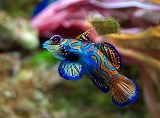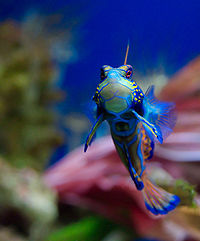
Mandarinfish
Encyclopedia
The Mandarinfish or Mandarin dragonet (Synchiropus splendidus), is a small, brightly-colored member of the dragonet
family, which is popular in the saltwater aquarium
trade. The mandarinfish is native to the Pacific, ranging approximately from the Ryukyu Islands
south to Australia
.
Herre, an American ichthyologist working in the Philippines
. It was later placed in genus Synchiropus. The generic name Synchiropus is from Ancient Greek
syn-, meaning "together", and -chiropus meaning "hand-foot". The specific epithet splendidus is from Latin for splendid.
The common name of the Mandarinfish comes from its extremely vivid colouration, evoking the robes of an Imperial Chinese mandarin
.
Other common names include Mandarin goby, Green mandarin, Striped mandarinfish, Striped dragonet, Green dragonet and sometimes Psychedelic mandarinfish.
The similarly named mandarin fish (Siniperca chuatsi), properly known as the Chinese perch, is only distantly related.
The Mandarinfish belongs to the perciform family Callionymidae, the dragonets, which counts 10 genera and more than 182 species. Genus Synchiropus counts 51 species, divided into 10 subgenera
. The Mandarinfish is in subgenus Synchiropus (Pterosynchiropus) along with the Australian LSD-fish (S. occidentalis) and the LSD- or psychedelic fish (S. picturatus
).
s, or pigment-containing and light-reflecting cells. In all other known cases, the colour blue comes from thin-film interference from piles of flat, thin and reflecting purine
crystals.
 Mandarinfish are reef dwellers, preferring sheltered lagoons and inshore reefs. While they are slow-moving and fairly common within their range, they are not easily seen due to their bottom-feeding habit and their small size (reaching only about 6 cm). They feed primarily on small crustacean
Mandarinfish are reef dwellers, preferring sheltered lagoons and inshore reefs. While they are slow-moving and fairly common within their range, they are not easily seen due to their bottom-feeding habit and their small size (reaching only about 6 cm). They feed primarily on small crustacean
s and other invertebrate
s.
, polychaete worms
, small gastropods
, gammaridean amphipods
, fish eggs and ostracod
s.
In the wild, feeding is continuous during daytime; the fish peck selectively at small prey trapped on corral substrate in a home range of many square meters.
s (as in the wild), though individuals that do acclimatize to aquarium food are considered to be quite hardy and highly resistant to diseases such as ich
. They cannot contract the disease Ichthyophthirius because they do not have the skin type that this common aquarium disease affects.
The mandarinfish appeared on a 39 kip
postage stamp
from Laos
issued in 1987, and a 40 cent postage stamp of the Federated States of Micronesia
issued on 26 August 1993.
Dragonet
Dragonets are small, perciform, marine fish of the diverse family Callionymidae . Found mainly in the tropical waters of the western Indo-Pacific, the family contains approximately 186 species in 18 genera. The Draconettidae may be considered a sister family, whose members are very much alike,...
family, which is popular in the saltwater aquarium
Aquarium
An aquarium is a vivarium consisting of at least one transparent side in which water-dwelling plants or animals are kept. Fishkeepers use aquaria to keep fish, invertebrates, amphibians, marine mammals, turtles, and aquatic plants...
trade. The mandarinfish is native to the Pacific, ranging approximately from the Ryukyu Islands
Ryukyu Islands
The , also known as the , is a chain of islands in the western Pacific, on the eastern limit of the East China Sea and to the southwest of the island of Kyushu in Japan. From about 1829 until the mid 20th century, they were alternately called Luchu, Loochoo, or Lewchew, akin to the Mandarin...
south to Australia
Australia
Australia , officially the Commonwealth of Australia, is a country in the Southern Hemisphere comprising the mainland of the Australian continent, the island of Tasmania, and numerous smaller islands in the Indian and Pacific Oceans. It is the world's sixth-largest country by total area...
.
Taxonomy and etymology
The Mandarinfish was first described as Callionymus splendidus in 1927 by Albert WilliamHerre, an American ichthyologist working in the Philippines
Philippines
The Philippines , officially known as the Republic of the Philippines , is a country in Southeast Asia in the western Pacific Ocean. To its north across the Luzon Strait lies Taiwan. West across the South China Sea sits Vietnam...
. It was later placed in genus Synchiropus. The generic name Synchiropus is from Ancient Greek
Ancient Greek
Ancient Greek is the stage of the Greek language in the periods spanning the times c. 9th–6th centuries BC, , c. 5th–4th centuries BC , and the c. 3rd century BC – 6th century AD of ancient Greece and the ancient world; being predated in the 2nd millennium BC by Mycenaean Greek...
syn-, meaning "together", and -chiropus meaning "hand-foot". The specific epithet splendidus is from Latin for splendid.
The common name of the Mandarinfish comes from its extremely vivid colouration, evoking the robes of an Imperial Chinese mandarin
Mandarin (bureaucrat)
A mandarin was a bureaucrat in imperial China, and also in the monarchist days of Vietnam where the system of Imperial examinations and scholar-bureaucrats was adopted under Chinese influence.-History and use of the term:...
.
Other common names include Mandarin goby, Green mandarin, Striped mandarinfish, Striped dragonet, Green dragonet and sometimes Psychedelic mandarinfish.
The similarly named mandarin fish (Siniperca chuatsi), properly known as the Chinese perch, is only distantly related.
The Mandarinfish belongs to the perciform family Callionymidae, the dragonets, which counts 10 genera and more than 182 species. Genus Synchiropus counts 51 species, divided into 10 subgenera
Subgenus
In biology, a subgenus is a taxonomic rank directly below genus.In zoology, a subgeneric name can be used independently or included in a species name, in parentheses, placed between the generic name and the specific epithet: e.g. the Tiger Cowry of the Indo-Pacific, Cypraea tigris Linnaeus, which...
. The Mandarinfish is in subgenus Synchiropus (Pterosynchiropus) along with the Australian LSD-fish (S. occidentalis) and the LSD- or psychedelic fish (S. picturatus
Synchiropus picturatus
Synchiropus picturatus is a Dragonet from the Indo-West Pacific. It occasionally makes its way into the aquarium trade, where it is commonly known as the Spotted Mandarin or Target Mandarin. It grows to a size of 7 cm in length....
).
Description
To date, S. splendidus is one of only two animal species known to have blue colouring because of cellular pigment, the other being the closely related LSD-fish (S. picturatus). The name "cyanophore" was proposed for the blue chromatophoreChromatophore
Chromatophores are pigment-containing and light-reflecting cells found in amphibians, fish, reptiles, crustaceans, and cephalopods. They are largely responsible for generating skin and eye colour in cold-blooded animals and are generated in the neural crest during embryonic development...
s, or pigment-containing and light-reflecting cells. In all other known cases, the colour blue comes from thin-film interference from piles of flat, thin and reflecting purine
Purine
A purine is a heterocyclic aromatic organic compound, consisting of a pyrimidine ring fused to an imidazole ring. Purines, including substituted purines and their tautomers, are the most widely distributed kind of nitrogen-containing heterocycle in nature....
crystals.
Ecology

Crustacean
Crustaceans form a very large group of arthropods, usually treated as a subphylum, which includes such familiar animals as crabs, lobsters, crayfish, shrimp, krill and barnacles. The 50,000 described species range in size from Stygotantulus stocki at , to the Japanese spider crab with a leg span...
s and other invertebrate
Invertebrate
An invertebrate is an animal without a backbone. The group includes 97% of all animal species – all animals except those in the chordate subphylum Vertebrata .Invertebrates form a paraphyletic group...
s.
Diet
Based on the gut analyses of 7 wild fish Sadovy et al. (2001) determined that the mandarinfish has a mixed diet that consists of harpacticoid copepodsHarpacticoida
Harpacticoida is an order of copepods, in the Subphylum Crustacea. This order comprises 463 genera and about 3,000 species. Members of it are benthic copepods found throughout the world in the marine environment and in fresh water...
, polychaete worms
Polychaete
The Polychaeta or polychaetes are a class of annelid worms, generally marine. Each body segment has a pair of fleshy protrusions called parapodia that bear many bristles, called chaetae, which are made of chitin. Indeed, polychaetes are sometimes referred to as bristle worms. More than 10,000...
, small gastropods
Gastropoda
The Gastropoda or gastropods, more commonly known as snails and slugs, are a large taxonomic class within the phylum Mollusca. The class Gastropoda includes snails and slugs of all kinds and all sizes from microscopic to quite large...
, gammaridean amphipods
Gammaridea
Gammaridea is a suborder of small, shrimp-like crustaceans in the order Amphipoda. It contains about 7,275 of the 7,900 described species of amphipods, in approximately 1,000 genera, divided among around 125 families. Gammaridea includes almost all freshwater amphipods , as well as many marine...
, fish eggs and ostracod
Ostracod
Ostracoda is a class of the Crustacea, sometimes known as the seed shrimp because of their appearance. Some 65,000 species have been identified, grouped into several orders....
s.
In the wild, feeding is continuous during daytime; the fish peck selectively at small prey trapped on corral substrate in a home range of many square meters.
Relationship to humans
Despite their popularity in the aquarium trade, mandarinfish are considered difficult to keep, as their feeding habits are very specific. Some fish never adapt to aquarium life, refusing to eat anything but live amphipods and copepodCopepod
Copepods are a group of small crustaceans found in the sea and nearly every freshwater habitat. Some species are planktonic , some are benthic , and some continental species may live in limno-terrestrial habitats and other wet terrestrial places, such as swamps, under leaf fall in wet forests,...
s (as in the wild), though individuals that do acclimatize to aquarium food are considered to be quite hardy and highly resistant to diseases such as ich
Ichthyophthirius
Ichthyophthirius multifiliis is a common disease of freshwater fish. It is caused by the protozoa Ichtyopthirius. Ich is one of the most common and persistent diseases.The protozoan is an ectoparasite...
. They cannot contract the disease Ichthyophthirius because they do not have the skin type that this common aquarium disease affects.
The mandarinfish appeared on a 39 kip
Lao kip
The kip "Currency Lao Kip") is the currency of Laos since 1952. One kip is divided into 100 att . The official name is: ເງີນກີບລາວ, lit. Other languages say: ; code: LAK; sign: ' or ', encoded .-Free Lao Kip:...
postage stamp
Postage stamp
A postage stamp is a small piece of paper that is purchased and displayed on an item of mail as evidence of payment of postage. Typically, stamps are made from special paper, with a national designation and denomination on the face, and a gum adhesive on the reverse side...
from Laos
Laos
Laos Lao: ສາທາລະນະລັດ ປະຊາທິປະໄຕ ປະຊາຊົນລາວ Sathalanalat Paxathipatai Paxaxon Lao, officially the Lao People's Democratic Republic, is a landlocked country in Southeast Asia, bordered by Burma and China to the northwest, Vietnam to the east, Cambodia to the south and Thailand to the west...
issued in 1987, and a 40 cent postage stamp of the Federated States of Micronesia
Federated States of Micronesia
The Federated States of Micronesia or FSM is an independent, sovereign island nation, made up of four states from west to east: Yap, Chuuk, Pohnpei and Kosrae. It comprises approximately 607 islands with c...
issued on 26 August 1993.

